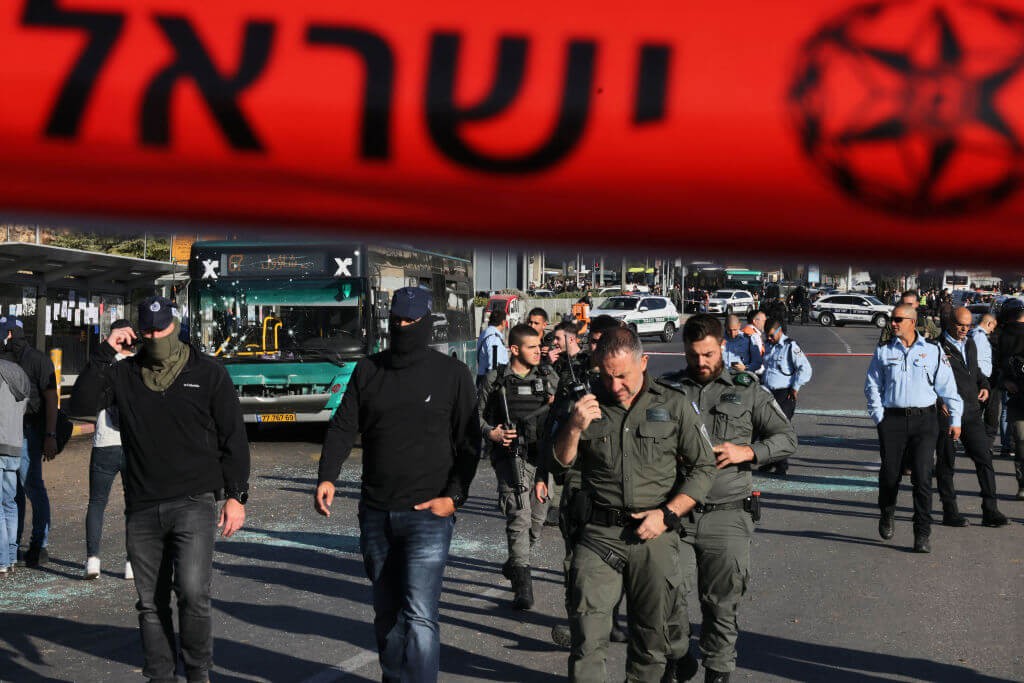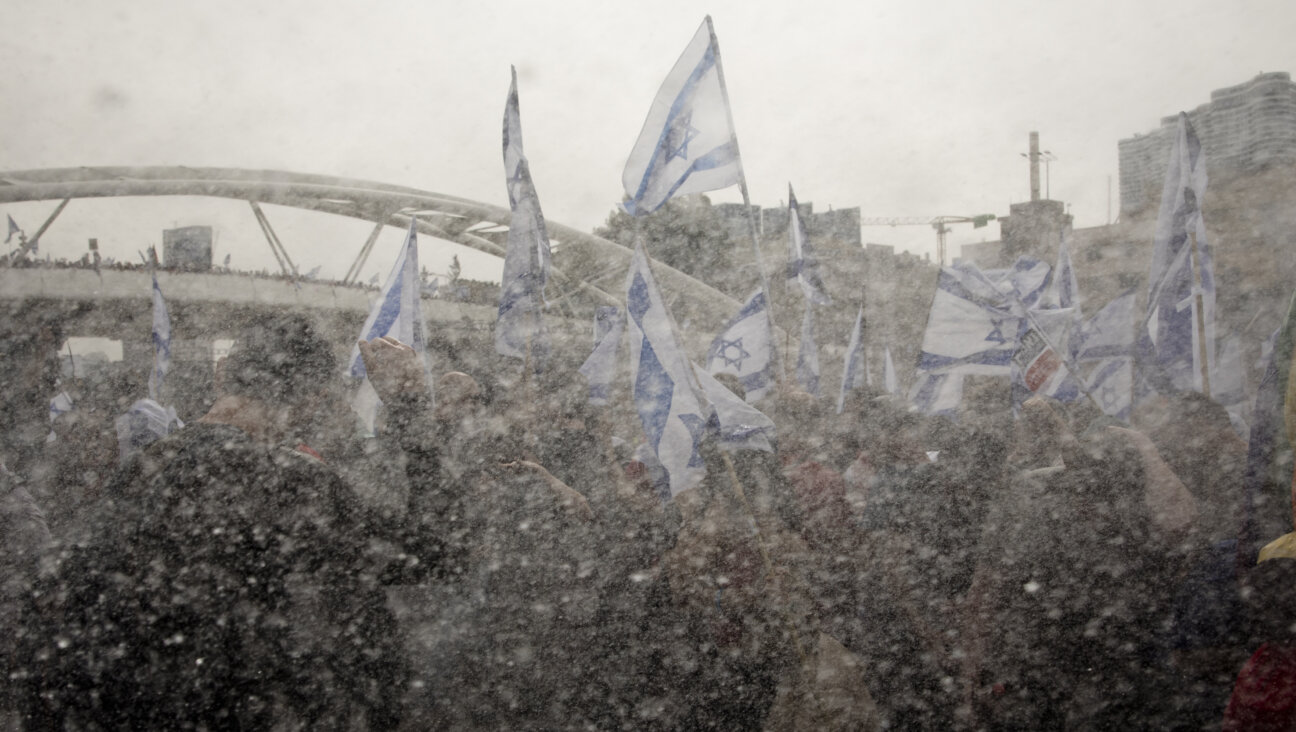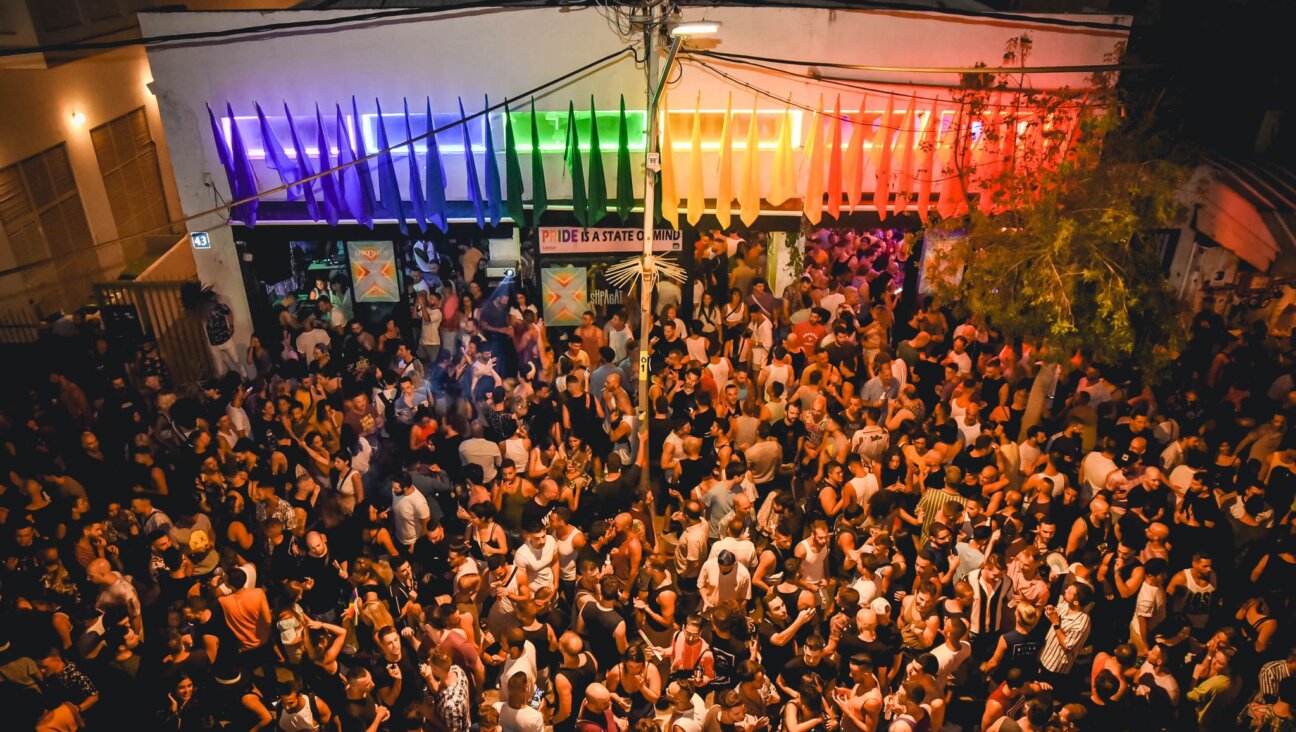Jerusalem twin bombings: Deadly innovation stirs old traumas
While Jerusalem residents have seen their share of deadly attacks, the twin bombings carry hallmarks that have rarely been seen in the city

Israeli security forces gather at the scene of an explosion at a bus stop in Jerusalem on November 23, 2022. Photo by Getty Images
This article originally appeared on Haaretz, and was reprinted here with permission. Sign up here to get Haaretz’s free Daily Brief newsletter delivered to your inbox.
Jerusalem had almost managed to forget the sights seen on Wednesday morning at the site of the terror attacks at the entrance to the capital. Police officers from the bomb squad are crawling around searching for remnants of the bombs, shattered bicycles, glass shards and rocks spread over a large area – and huge traffic jams because of the closing of the roads leading to the city.
It’s not that Jerusalem has really forgotten what terrorist attacks are, in recent years dozens of such attacks have taken place in the capital – but none of them are like this attack – not in means, location or the victims.
The violence in Jerusalem is usually divided into waves – the first and second intifadas, the Abu Khdeir events, the knife intifada of 2015, the terror attack at the Temple Mount in 2017 and the metal detector events, the Ramadan 2021 incidents and others.
Every wave has its own characteristics, but since 2014 there has been a rather regular model of terrorist attacks in Jerusalem – a lone assailant or two who were not sent by any specific terrorist group, armed with knives, or in the worst case improvised guns, who attack police and Border Police officers at the Damascus Gate, the gates to the Temple Mount or along the Seam Line.
These attacks mostly end with a few people wounded and the death of the terrorist. There have been exceptions – for example, the horrible memory of the worshippers murdered in a synagogue in the Har Nof neighborhood in 2014. But the vast majority of the terror attacks in recent years did not occur in the western part of the city, they did not make use of explosive devices and they were not especially sophisticated.
This morning’s attacks broke all those rules – a hellish integrated attack at the western edge of the capital with the explosives – so it looks for now – detonated remotely, without a suicide bomber. In order to remember a similar incident we have to go back to 2011, when a bomb exploded next to a kiosk in the area of the International Convention Center, better known by locals as Binyanei Hauma, and a woman was killed and dozens were injured. The site was already known as the kiosk that had been blown up because of a previous terrorist bombing that took place there 15 years earlier.
But for most adult Jerusalemites, Wednesday morning’s scenes remind them of other periods – the Second Intifada, the period of fear in Jerusalem. During that time a well-known rule existed in the capital that if you hear three ambulance sirens in a row then there had been a terror attack – and you needed to start checking where your family is.
Mostly, they were suicide bombings with mass casualties on a bus or in a café. This bitter period led to the construction of the separation barrier and to the deep penetration of the Shin Bet security service in eastern Jerusalem and in the West Bank. It seemed that the security forces neutralized the ability of the Palestinian terrorist organizations to produce complicated terror attacks that required knowledge, materials, a laboratory, driver and commander. The explosions this morning ended this illusion.
The bus stop at the entrance to the capital is a sort of Jerusalem institution, a miniature central bus station. Hundreds of people, most of them Haredim from the nearby neighborhoods, crowd together there every morning waiting for buses or to hitch a ride. It seems that whoever hid the bomb knew the site and the crowding there. From the damage caused, it seems that the bomb was placed behind the bus stop.
For now, the terrorist attack has managed to seriously disrupt life in the city. Transportation has come to a stop, ambulances and police cars continue to drive with their sirens wailing, politicians have begun arriving at the scene, and hundreds of Haredim have gathered in curiosity around it.
Another important difference between the terrorist attacks we have become used to in recent years and what happened on Wednesday morning is the intensity of the disruption of life in the city. The teams from the police and municipality became very proficient in restoring the normal routine at the scene of an attack.
After an investigation and evacuation of the wounded, a cleaning crew from the city would arrive and sometimes, within an hour or two, it was impossible to see that anything had happened. On Wednesday it was totally different. The bombing succeeded in severely disrupting life in the capital.
The bomb squad officers continued to sweep up and gather ball bearings and other pieces of metal that most likely were part of the bomb, ambulances and police cars continued to drive with their sirens wailing and a helicopter hovered overhead. Politicians also began arriving at the scene, as did curious Haredim. One of them thought he recognized a Palestinian driver and shouted “Death to Arabs” at him.
The big question that hovered over the capital this morning is whether this is just the beginning of a new era with terror attacks we have preferred to forget? Are we at the start of a new wave?
A message from our Publisher & CEO Rachel Fishman Feddersen

I hope you appreciated this article. Before you go, I’d like to ask you to please support the Forward’s award-winning, nonprofit journalism so that we can be prepared for whatever news 2025 brings.
At a time when other newsrooms are closing or cutting back, the Forward has removed its paywall and invested additional resources to report on the ground from Israel and around the U.S. on the impact of the war, rising antisemitism and polarized discourse.
Readers like you make it all possible. Support our work by becoming a Forward Member and connect with our journalism and your community.
— Rachel Fishman Feddersen, Publisher and CEO





























